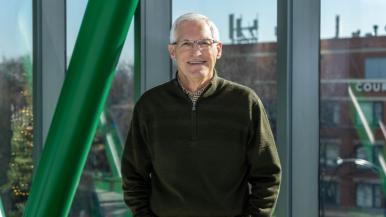You might say Bob Costigan, 75, is a lucky guy. After spending 20 years in the military, then working all over the country as a civil engineer, he happily retired in 2015. Settling in Chicago to be close to his three grandkids with his wife, he now spends his time traveling the world and golfing.
“Last year, I was out in southern California, and at the pinnacle of my age, I got a hole-in-one,” he says.
But later that year, at a routine dermatology appointment, he was diagnosed with three different types of skin cancer that threatened his life. It led to procedures, scans, lab work and more.
One of his cancers appeared on his nose. While it was deemed curable with Mohs surgery, the procedure required skin from his nose to be excised, or removed. Costigan worried what he might look like and how the procedure would affect his life afterward.
Even though it might seem that Costigan’s luck had run out, he still had some good fortune left. That’s because Michael Eggerstedt, MD, a facial plastic and reconstructive surgeon at RUSH, knew he could help Costigan get his nose and self-confidence back — and get him back on the golf course.
More than looks
When any event, including surgery, changes your appearance, the effects go beyond simply looking different in the mirror.
“Many studies show that even small scars or alterations in our facial appearance have profound effects on our self-esteem and quality of life,” Dr. Eggerstedt says. “Studies also show that people treat us differently following these alterations.”
When the nose, specifically, is affected, things can get even more complicated. It can change the way you experience the world through your sense of smell, the way you breathe, how you sound when you speak and more.
“We need to restore both form and function to account for the five senses, nasal breathing, eating, speaking and appearance,” Dr. Eggerstedt says.
In Costigan’s case, the best way to do that was with a procedure using his own skin and, odd as it may sound, connecting part of his forehead to his nose.
Fixing a nose with the forehead
The day after Costigan had surgery to remove the cancer on his nose, he went in for a combined resection of his other two skin cancers, one on his ear and another on his shoulder. Dr. Eggerstedt then performed immediate reconstruction of his nose and skin cancers alongside Kerstin Stenson, MD, a head and neck oncologist at RUSH.
The procedure he used is called a forehead flap. It involves taking a section of skin from the forehead, then attaching it to the nose while it is still connected to its blood supply. About a month later, the surgeon fully detaches the skin from the forehead and performs some finishing touches. This method helps the skin color and texture match the section that was removed from the nose.
“I’ll admit, I didn’t go anywhere for about three weeks because I didn’t want to scare anybody,” Costigan says. “But after that, I went around, and I could be in public again. It’s beyond amazing. It’s a miracle that I even have something that I can touch at the end of my nose.”
With his nose fully reconstructed, Costigan now feels confident enough to return to his normal social life.
“I go to church. I’m a greeter,” he says. “Most people don’t comment at all. So that’s the success that Dr. Eggerstedt has been able to achieve with me.”
Dr. Eggerstedt credits a lot of Costigan’s successful treatment to RUSH’s full skin cancer team who work together, including dermatologists, oncologists, plastic and reconstructive surgeons and more.
“Bob is looking great, feeling himself and back to playing golf with his wife,” Dr. Eggerstedt says. “He bounced back so quickly that I had to remind him to keep his incisions out of the sun.”
Costigan is certainly still lucky. But more than his luck, he thanks his physicians, the care coordinators who helped him get appointments and the rest of the staff who made everything go smoothly.
“I’m convinced that every person I’ve met here isn’t in it for the money,” he says. “They really care. It’s not just the doctors. The staff, the people that do scheduling, are just as empathetic, just as concerned. They are phenomenal. I couldn’t be more impressed with everybody from the highest-ranking doctor to the person who’s cleaning up the buildings.”
Dr. Eggerstedt also has some advice if you’re concerned about a procedure that might change your appearance.
“Get multiple opinions, and especially from surgeons who perform these complex reconstructions regularly,” he says. “There are options in 2024 that can provide excellent outcomes for you.”
If you need facial plastic and reconstruction services, call RUSH at (888) 352-7874. You can also visit our Facial Plastic and Reconstruction Services page to learn more.




